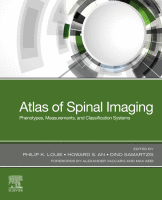Browse content
Table of contents
Actions for selected chapters
- Full text access
- Book chapterNo access
Chapter 1 - Introduction
Philip K. Louie, Dino Samartzis and Howard S. An
Pages 1-2 - Book chapterNo access
Index
Pages 259-262
About the book
Description
Spine-related pain is the world’s leading disabling condition, affecting every population and a frequent reason for seeking medical consultation and obtaining imaging studies. Numerous spinal phenotypes (observations/traits) and their respective measurements performed on various spine imaging have been shown to directly correlate and predict clinical outcomes. Atlas of Spinal Imaging: Phenotypes, Measurements and Classification Systems is a comprehensive visual resource that highlights various spinal phenotypes on imaging, describes their clinical and pathophysiological relevance, and discusses and illustrates their respective measurement techniques and classifications. Complies the knowledge and expertise of Dr. Dino Samartzis, the preeminent global authority on spinal phenotypes who has discovered and proposed new phenotypes and classification schemes; Dr. Howard S. An, a leading expert in patient management and at the forefront of 3D imaging of various spinal phenotypes; and Dr. Philip Louie, a young surgeon who is involved in one of the largest machine learning initiatives of spinal phenotyping.
*Includes a Foreword by renowed spine surgeons Alexander Vaccaro and Max Aebi*
Spine-related pain is the world’s leading disabling condition, affecting every population and a frequent reason for seeking medical consultation and obtaining imaging studies. Numerous spinal phenotypes (observations/traits) and their respective measurements performed on various spine imaging have been shown to directly correlate and predict clinical outcomes. Atlas of Spinal Imaging: Phenotypes, Measurements and Classification Systems is a comprehensive visual resource that highlights various spinal phenotypes on imaging, describes their clinical and pathophysiological relevance, and discusses and illustrates their respective measurement techniques and classifications. Complies the knowledge and expertise of Dr. Dino Samartzis, the preeminent global authority on spinal phenotypes who has discovered and proposed new phenotypes and classification schemes; Dr. Howard S. An, a leading expert in patient management and at the forefront of 3D imaging of various spinal phenotypes; and Dr. Philip Louie, a young surgeon who is involved in one of the largest machine learning initiatives of spinal phenotyping.
*Includes a Foreword by renowed spine surgeons Alexander Vaccaro and Max Aebi*
Details
ISBN
978-0-323-76111-6
Language
English
Published
2021
Copyright
Copyright © 2022 Elsevier Inc. All rights reserved.
Imprint
Elsevier
